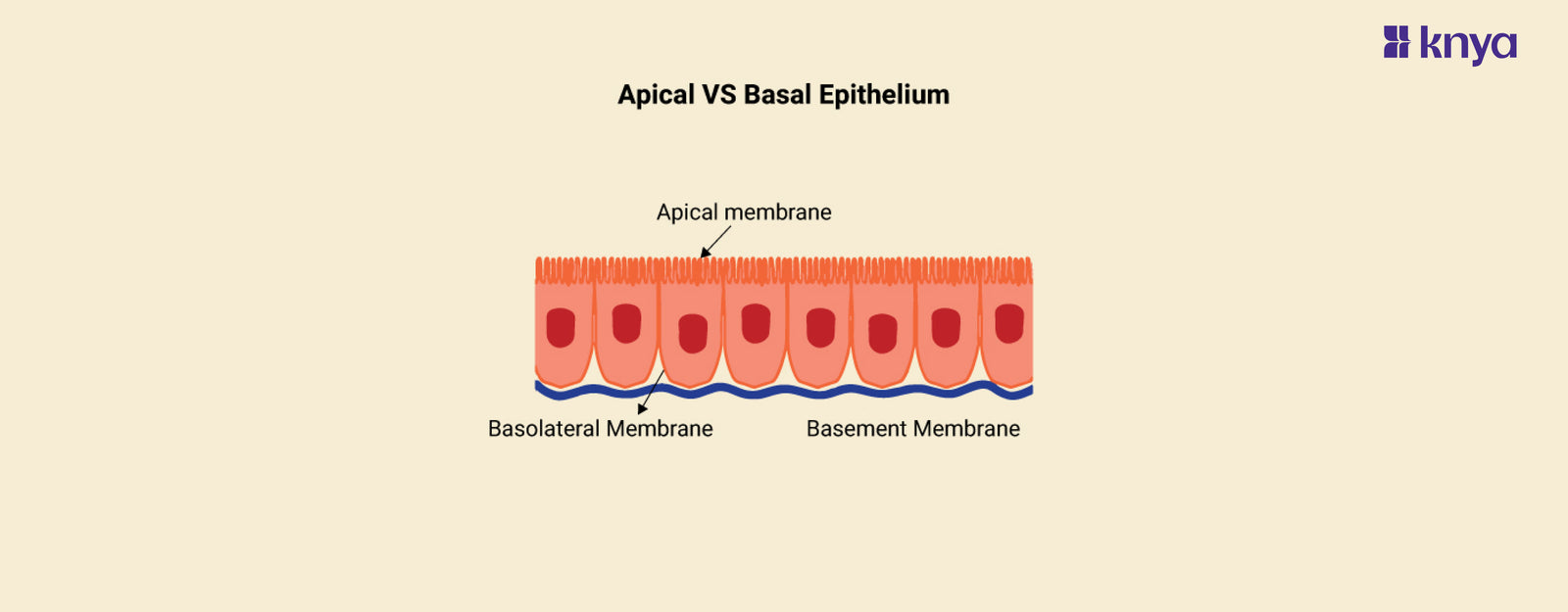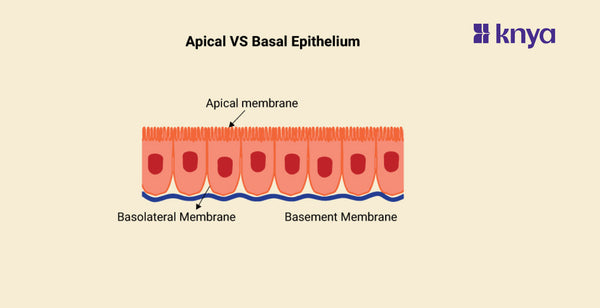Difference between Apical vs Basal Epithelium: Apical and Basal Epithelium constitute distinct surfaces of epithelial cells. The Apical surface faces lumens or outside environments, showcasing Specialised systems for features including absorption or secretion. Contrastingly, the basal surface adheres to the basement membrane, offering structural help and anchorage to underlying tissues. These surfaces play critical roles in retaining tissue integrity, facilitating selective change, and executing precise physiological capabilities crucial for the body's normal functioning.
Difference between Apical and Basal Epithelium
Apical epithelium, facing lumens or external environments, absorbs and secretes, while basal epithelium, attached to the basement membrane, supports and anchors tissues, featuring hemidesmosomes. The table below provides the differences between Apical and Basal Epithelium.
|
Feature |
Apical Epithelium |
Basal Epithelium |
|
Location |
Faces lumen, cavity, or external environment |
The base of epithelial tissue, attached to the basement membrane |
|
Function |
Specialised for absorption, secretion, and sensation |
Provides structural support, and anchorage for epithelial cells, and facilitates the nutrient exchange |
|
Specialised Structures |
Microvilli, cilia |
Hemidesmosomes |
|
Composition |
A single layer of epithelial cells |
A single layer of epithelial cells |
|
Examples |
Intestinal lining, respiratory tract, kidney tubules |
The basal layer of skin epidermis, glandular epithelia |
Browse The Best Scrubs Collection!
What is Apical Epithelium?
Apical Epithelium refers to the surface of epithelial cells that face a lumen, cavity, or external environment. This specialised surface frequently features microvilli, cilia, or other structures that facilitate capabilities including absorption, secretion, or sensation. In various tissues, together with the intestines, kidneys, and respiratory tract, the Apical Epithelium plays a crucial role in mediating interactions with the surrounding surroundings and executing particular physiological duties crucial for the organism's survival and well-being.
Features of Apical Epithelium
- Microvilli: These are finger-like projections extending from the Apical surface, considerably increasing floor vicinity for absorption and secretion. Found in cells lining the small intestine and kidney tubules.
- Cilia: Hair-like systems that protrude from the Apical floor and serve numerous functions which include transferring materials alongside the surface, as seen within the respiration tract to help get rid of mucus and debris.
- Glycocalyx: A layer of glycoproteins and polysaccharides protecting the Apical surface, contributing to mobile protection, lubrication, and cell-mobile popularity.
- Secretory Vesicles: Specialised cells in positive epithelia include secretory vesicles at their Apical ends, freeing unique materials into the lumen or outside environment.
- Tight Junctions: Formed between adjacent epithelial cells near the Apical surface, creating a barrier that regulates the passage of ions and molecules through the intercellular area.
What is Basal Epithelium?
Basal Epithelium refers back to the decreased floor of epithelial which is attached to the basement membrane, a Specialised extracellular matrix structure. This layer affords structural help and anchorage for the epithelial tissue to the underlying connective tissue. The Basal Epithelium also helps the alternate of nutrients and waste merchandise among the epithelial cells and the encircling tissues.
Features of Basal Epithelium
- Attachment Structures: Basal epithelial cells are anchored to the basement membrane through specialised junctions known as hemidesmosomes, which provide sturdy adhesion and stability.
- Basal Lamina: The Basal Epithelium contributes to the formation of the basal lamina, a skinny layer of extracellular matrix that separates the epithelial cells from the underlying connective tissue. This lamina serves as a scaffold for cell attachment and regulates molecular alternations among the epithelium and surrounding tissue.
- Selective Permeability: The Basal Epithelium participates in regulating the passage of molecules and ions among the epithelial layer and the underlying tissues, contributing to selective permeability and barrier features.
- Metabolic Support: Basal epithelial cells are concerned with metabolic strategies along with nutrient uptake and waste removal, supporting the metabolic wishes of the epithelial tissue.
Shop Best Lab Coats From Here!
Similarities between Apical vs Basal Epithelium
- Cellular Composition: Both Apical and Basal Epithelium are composed of epithelial cells, which can be tightly packed and form non-stop layers covering surfaces in the frame.
- Attachment to Basement Membrane: While the Apical Epithelium faces the lumen or external surroundings, and the Basal Epithelium attaches to the basement membrane, each layer interacts with this specialised extracellular matrix shape. They make contributions to its formation and are anchored to it through diverse cell-matrix junctions.
- Regulation of Permeability: Both Apical and Basal Epithelium make contributions to the regulation of molecular and ion fluxes across epithelial tissues.
In summary, Apical and Basal Epithelium consult with distinctive surfaces of epithelial cells. The Apical floor faces a lumen or outside surroundings and is frequently specialised for precise features, at the same time as the basal floor is hooked up to the basement membrane and offers structural help and attachment to underlying tissues.
Order the Best Jogger Scrub From Here!
| Check out More Articles | |
| Difference Between Cartilage And Bone | |
| Difference Between Endocrine And Exocrine Glands | |
| Difference Between Cell Wall And Cell Membrane | |















